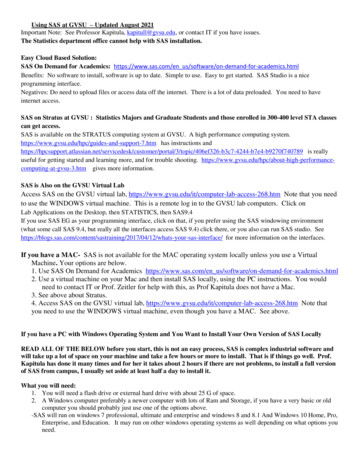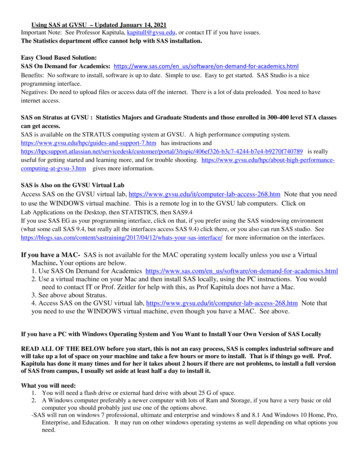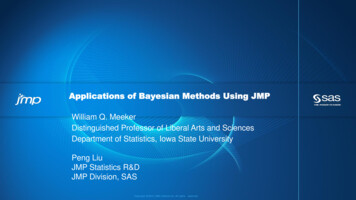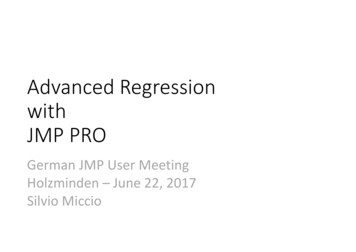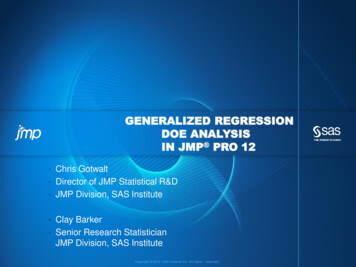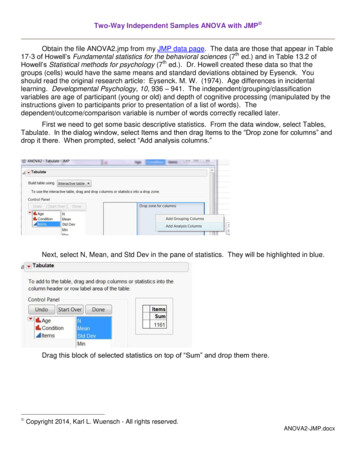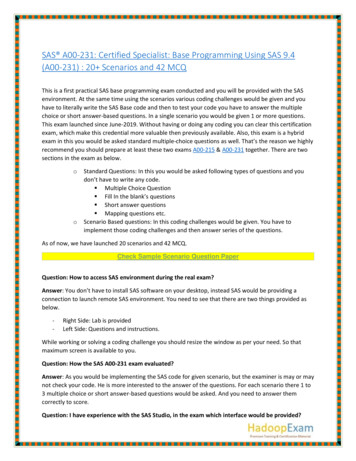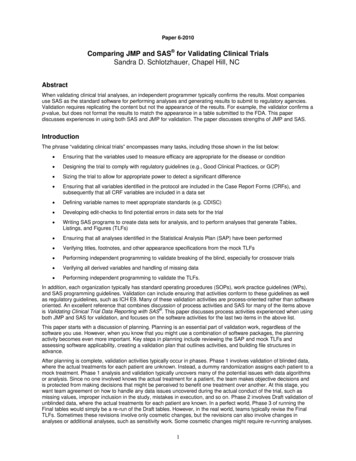
Transcription
Paper 6-2010Comparing JMP and SAS for Validating Clinical TrialsSandra D. Schlotzhauer, Chapel Hill, NCAbstractWhen validating clinical trial analyses, an independent programmer typically confirms the results. Most companiesuse SAS as the standard software for performing analyses and generating results to submit to regulatory agencies.Validation requires replicating the content but not the appearance of the results. For example, the validator confirms ap-value, but does not format the results to match the appearance in a table submitted to the FDA. This paperdiscusses experiences in using both SAS and JMP for validation. The paper discusses strengths of JMP and SAS.IntroductionThe phrase “validating clinical trials” encompasses many tasks, including those shown in the list below: Ensuring that the variables used to measure efficacy are appropriate for the disease or condition Designing the trial to comply with regulatory guidelines (e.g., Good Clinical Practices, or GCP) Sizing the trial to allow for appropriate power to detect a significant difference Ensuring that all variables identified in the protocol are included in the Case Report Forms (CRFs), andsubsequently that all CRF variables are included in a data set Defining variable names to meet appropriate standards (e.g. CDISC) Developing edit-checks to find potential errors in data sets for the trial Writing SAS programs to create data sets for analysis, and to perform analyses that generate Tables,Listings, and Figures (TLFs) Ensuring that all analyses identified in the Statistical Analysis Plan (SAP) have been performed Verifying titles, footnotes, and other appearance specifications from the mock TLFs Performing independent programming to validate breaking of the blind, especially for crossover trials Verifying all derived variables and handling of missing data Performing independent programming to validate the TLFs.In addition, each organization typically has standard operating procedures (SOPs), work practice guidelines (WPs),and SAS programming guidelines. Validation can include ensuring that activities conform to these guidelines as wellas regulatory guidelines, such as ICH E9. Many of these validation activities are process-oriented rather than softwareoriented. An excellent reference that combines discussion of process activities and SAS for many of the items aboveis Validating Clinical Trial Data Reporting with SAS . This paper discusses process activities experienced when usingboth JMP and SAS for validation, and focuses on the software activities for the last two items in the above list.This paper starts with a discussion of planning. Planning is an essential part of validation work, regardless of thesoftware you use. However, when you know that you might use a combination of software packages, the planningactivity becomes even more important. Key steps in planning include reviewing the SAP and mock TLFs andassessing software applicability, creating a validation plan that outlines activities, and building file structures inadvance.After planning is complete, validation activities typically occur in phases. Phase 1 involves validation of blinded data,where the actual treatments for each patient are unknown. Instead, a dummy randomization assigns each patient to amock treatment. Phase 1 analysis and validation typically uncovers many of the potential issues with data algorithmsor analysis. Since no one involved knows the actual treatment for a patient, the team makes objective decisions andis protected from making decisions that might be perceived to benefit one treatment over another. At this stage, youwant team agreement on how to handle any data issues uncovered during the actual conduct of the trial, such asmissing values, improper inclusion in the study, mistakes in execution, and so on. Phase 2 involves Draft validation ofunblinded data, where the actual treatments for each patient are known. In a perfect world, Phase 3 of running theFinal tables would simply be a re-run of the Draft tables. However, in the real world, teams typically revise the FinalTLFs. Sometimes these revisions involve only cosmetic changes, but the revisions can also involve changes inanalyses or additional analyses, such as sensitivity work. Some cosmetic changes might require re-running analyses.1
For example, suppose the team decides to increase the number of decimal places for descriptive statistics to fourfrom three. If the validation program used previously shows statistics to only three decimal places, this cosmeticchange will require re-programming and revalidation activities. However, if the validation program shows statistics tofour (or more) decimal places, this cosmetic change will not require re-running any programs. Instead, it will requireonly rechecking the new table using the previously-generated validation results.For each phase, validation follows a logical pattern. First, validate the data according to plans. Next, validate thetables and listings. Finally, validate the figures, which typically depend on the tables, listings, or supplementalanalyses. This paper follows the same logical pattern. After discussing planning, the paper discusses the strengths ofJMP and SAS for validating data, then tables and listings, and finally figures. The paper focuses on JMP, not on therecently released JMP Clinical software. This paper also assumes that validation involves independent programmingand duplication of results. In some cases, validation involves peer review of the programs used to create the results—discussing processes and best practices for peer review is another paper.The paper ends with a summary of strengths for JMP and SAS, and also compares some practical aspects of usingeach software package as an independent consultant.Reviewing the SAP and Mock TLFsThe SAP explains the analyses for the trial. This document provides very detailed descriptions of what analyses areperformed, on what data, and under what conditions. The document also describes the populations for the analyses,such as “safety” or “intent-to-treat” (ITT), and defines the criteria for inclusion in the populations. When reviewing theSAP, assess software applicability for each validation activity. Reviewing the SAP will help you build the ValidationPlan.First, consider the data that will require validation. Are there calculated variables? Is missing data handled using LastObservation-Carried-Forward (LOCF) or other approaches? How many populations are there, and how are thesepopulations defined? When creating your Validation Plan, be sure to include discussion of how the data will bevalidated.Second, review the analyses and the populations for those analyses. Both JMP and SAS can perform many commonanalyses for trials, including ANOVA, ANCOVA, logistic regression, Chi-square, survival analyses, and more.However, SAS does provide many analyses that JMP does not. SAS also provides analyses in situations where JMPprovides an analysis in a subset of situations. Suppose the SAP proscribes the Fisher’s Exact Test. Both JMP andSAS can run this test for a 2x2 table. However, SAS can also run the test for larger tables. Before deciding whichsoftware package is applicable for an analysis, you must also consider the population.Third, review the mock TLFs and assess the ability to reproduce content. This is usually best performed along withthe review of analyses in the SAP. Focus on the descriptive and analytical statistics—many tables contain both. Inyour review, do not worry about the appearance of the table or listing. When validating results, your focus is oncontent and not on cosmetics.Creating the Validation PlanThe Validation Plan is a document that outlines validation activities for a clinical trial. Key inputs include the protocol,annotated Case Report Forms (CRFs), SAP, and mock TLFs. Figure 1 shows the table of contents for a sampleValidation Plan.Most of the topics discussed in a Validation Plan do not depend on the software used for validation activities. Forexample, the “General Methodology” section typically describes the validation approach for Blinded, Draft, and Finalphases, and defines when confirmatory reviews are appropriate.When you expect to use a combination of JMP and SAS for validation, the “Outputs” section can include text thatminimizes the need for revisions to the plan. For example, include the following text:The software used for a given activity may be defined as JMP and switched to SAS, or defined asSAS and switched to JMP, without requiring an update to this Validation Plan. The ValidationSummary documentation will identify the software used for each activity.Since obtaining all required signatures for the Validation Plan can be a lengthy process (depending on client SOPs),the text above allows you to change the software used without repeating the signature process.2
Figure 1. Sample Table of Contents for a Validation PlanThe Validation Plan Table details the validation activities for each data set, table, listing, and figure. Typically, eachitem forms a row in the table. Typical columns include the TLF number TLF title validation activities validator.The TLF number and title are important because table numbers sometimes change between the plans for a trial andthe final clinical study report (CSR). By providing both the number and title, you will be able to trace validationactivities throughout the trial.These validation activities should not reproduce the general activities described in the body of the validation plan. Thelist below shows sample validation activities. Verify the counts and frequencies in the table using JMP. Provide a PDF of the JMP results or a JMP journalas documentation. Verify the Fisher’s Exact Test for the 2xn table using SAS. Provide a PDF of the SAS output asdocumentation. Verify the p-values for the ANOVA using JMP and provide a PDF of the JMP results or JMP journal. Confirmthat the model used in the analysis is as described in the SAP. Verify the p-values from the statistical tests using either JMP or SAS, and provide appropriate PDFs todocument the results. Compare a 10% random sample from each treatment group to the raw data listing. Verify the values plotted in the figure against the supporting table (Table x.y).The items in the list identify the software used, how the results will be documented, and how validation outputs mightdiffer for different software. The fourth item shows an example of describing a validation activity when you do notknow in advance whether you will use JMP or SAS for validation. By allowing this flexibility in software choices, youcan avoid revisions later. Typically, a Validation Plan is not revised after the blind is broken. In those situations, theValidation Summary must describe any revisions to the planned validation and the reasons for those revisions.Since most trials involve multiple people performing validation, identify the validator. In some cases, the validators willbe from different companies. For example, my experience includes situations where a CRO performs validation on allsafety data sets and TLFs, and external statistical consultants perform validation on ITT data sets and TLFs. Byclearly identifying validators in the Validation Plan Table, you ensure that all data sets and TLFs are validated.3
Figure 2 provides an example of a sample Validation Summary.Figure 2. Sample Validation SummaryThe sample text in Figure 2 shows one approach to documenting which software package is used, and how thevalidation results are provided. The row for Table 1.1 describes validation using JMP, and the row for Table 1.2describes validation using SAS.Building File Structures in AdvanceA final aspect of planning is to build your file structures in advance. This best practice creates an organizationalstructure of folders that will allow for validation in JMP and in SAS.Figure 3 shows a sample file structure that is designed for both SAS and JMP to be used in validation. The Draftphase of validation is expanded to show the directory tree. The Blinded folder would contain a similar directory tree,as would the Final folder when it was created. The General folder contains important documents such as the SAP,Validation Plan, CRFs, protocol, and so on. The SOPs folder is important, as you might later need to prove that youfollowed relevant SOPs in performing your work. With multiple clients, disk space is cheap. Copy the appropriateSOPs for each trial you validate, and you will avoid time spent searching for the relevant SOPs in the future.4
Figure 3. Sample File StructureThe sample structure allows for incoming data in Zip files. If you receive data directly as SAS data sets or transportfiles, then you might want to rename folders to fit your needs. Given industry standards, you are unlikely to receiveJMP data tables. However, in validation activities, you will almost certainly create JMP data tables. By separating theSAS and JMP data into separate folders, you can separate incoming data and data that you create. If you also createyour own SAS data sets, perhaps for troubleshooting problems, you will want to create a separate folder for thosedata sets also.The sample structure allows for validation activities using both JMP and SAS. The “Validation PDFs” folder containsthe documentation for validation of each data set or TLF. This folder should include all PDFs that are referenced inthe Validation Summary Table, and also include the Validation Summary Table document. When naming these PDFs,develop a naming convention that allows for both a JMP PDF and a SAS PDF to support a single table. For example,you might base the naming convention on the assumption that most validation is done with JMP. Your validation fileswould be of the form “Table x y.PDF” for JMP validation, and of the form “Table x y SAS.PDF” for SAS validation ona table. Place all the raw JMP journals, which require JMP to open, in a folder. Place all the SAS programs in a folder.Similarly, place the raw SAS output and raw SAS logs in folders. For easier auditing, create PDFs of the SAS logs,and place those in another folder.This sample structure is a starting point. As you validate trials, you might need to add or delete folders to meet yourneeds. However, starting from a sample structure helps you organize information across trials for a given client, andacross clients. By storing all the client delivered information in the “Validation PDFs” folder, you can respond to followup requests or audits more quickly in the future.Validating DataThis paper discusses validating data in the contexts of confirming the accuracy of algorithms for derived variables,and for handling missing data. Programmers create derived variables for many reasons. Some derived variables aresimply flag variables that conveniently define whether a patient meets a set of criteria or not. In other cases, derivedvariables define the change in an efficacy measurement over time. Confirming this second type of derived variablecan be more complex when patients have missing data. The SAP defines how to handle missing data. Usually, theprocess involves some form of carrying forward the last nonmissing information. However, this definition can becomecomplex, and involve multiple decision points. For example, how do you handle a patient who participated in thescreening portion of the trial but never actually received treatment? Do you map their initial efficacy measurements5
(before treatment) to all the post-treatment efficacy timepoints in the trial? Or, do you define the post-treatmentmeasurements as missing? Sometimes, the SAP defines this process; other times, the clinical team makes thedecisions on blinded data. If the team makes decisions on blinded data, the Validation Summary should include adiscussion of these decisions. In addition, depending on client SOPs, you might need to store additional detail, suchas emails or memos-to-file.The Validation Plan should define whether validation is performed across the data set or on a subset. To clarify,suppose you anticipate some data will be missing. Does the plan define that validation will involve confirming theaccuracy for all missing data? Or, does the plan specify selecting a random sample (of 10%, for example) andconfirming the accuracy of that sample? In either case, allow for practical decision-making after the Validation Plan iscomplete. For example, suppose the plan defines a 10% stratified random sample by treatment to confirm LOCF.After the trial is complete, you find that very few patients have missing data—in fact, less than 10%. Instead of simplyfollowing the Validation Plan, the best practice is to make a practical decision and perform validation on all the data.The Validation Summary should describe this change from planned validation, and describe the reasons behind thedecision for the change. Depending on client SOPs, you might also need additional approval of any changes.Similarly, the Validation Plan should identify when validation of data sets is not needed. Generally, data is validated atthe Blinded and Draft phases. Most of the time, there are very few, if any, data changes between Draft and Finalphases. In those situations, you might choose to confirm that the planned changes were made, and choose not to revalidate other data elements. This choice depends on the complexity of the changes. If the data changes are complexenough that they might have impacted other observations, then you are more likely to want to re-validate.The next two topics discuss validating with JMP and SAS. The JMP topic is more extensive, given the audience forthis paper. Considerations in validating data with JMP apply to SAS as well, so the SAS topic focuses on additionalaspects of data validation when using SAS. In addition, these two topics focus on validating efficacy data sets.Validating safety data requires the same principles for derived variables.Validating with JMPJMP is designed for data exploration using a point-and-click interface. The result of this strength is that you canvalidate data using existing platforms, data management choices, and by creating formulas. Create a JMP journal todocument your activities. In the journal, use bulleted lists or notes to document activities, and the reasons behindthose activities. The journal should be complete enough that the reader does not require access to either the data orto JMP to confirm accuracy of your validation.Consider an example from a cholesterol trial. The SAP defines the ITT population as patients with a baselinemeasurement and at least one post-baseline measurement. Figure 4 shows an example of the JMP journal thatverifies the assignment of patients to the ITT population.Figure 4 shows the JMP journal, for comparison with later figures that show the PDF files created from journals. Thisvalidation uses a combination of TablesÆSummary and Subset to validate the ITT. The journal identifies the dataset, phase of validation, and purpose for this journal. Using text items (the bulleted list items), the journal defines theITT population. Then, the journal shows JMP activities to confirm that patients who are not included in the ITTpopulation are handled correctly, and shows selected variables for the one record with ITT 0. In general, data setscontain many more variables than you need to show in the journal. The second part of the journal confirms thatpatients who are included in the ITT population meet the criteria.Continuing the example from the cholesterol trial, suppose the SAP defines that missing efficacy measurements arehandled by carrying the last non-missing measurement forward. This is generally called “last-observation-carriedforward,” and abbreviated as LOCF. The SAP further defines that pre-treatment measurements are not carriedforward as post-treatment measurements. Figure 5 shows the journal to validate LOCF. The first part of the journalshows validation that can be easily checked visually. With only five patients where LOCF is used, building your ownflag variables to confirm LOCF might not be valuable. However, you won’t know in advance how many patients needto be checked. The second part of the journal in Figure 5 shows the results of building flag variables to check. Thisvalidation has two steps. First, create a variable that validates the LOCF. Second, use TablesÆSummary to list thevalues of the new variable.Figure 5 also illustrates one issue with JMP when using formulas. The Formula editor is very powerful; however,pasting formulas into a journal does not usually provide an easily readable version of the formula. Instead, copy theformula window to a document, and save the document as a PDF. In general, you can combine all the formulas into a“Process Notes” document. Figure 6 shows the formula used to perform the validation in Figure 5.Finally, Figure 5 illustrates a process approach. When you create new variables in JMP, use either a prefix or a suffix.This process helps you easily find the variables that you create, and separate those variables from the SAS data setvariables.When you create formulas for data validation, they are saved with the column in the data table. If you create a formulafor the Blinded phase, you can simply copy that formula to the same-named variable for the data table in the Draftphase. If you find that you use the same formula across multiple trials, you can create a template. This is simply a6
data set that contains all the columns needed and has no rows. When you get the new data for a trial, you can createall the new columns, and apply the formulas, by concatenating the template to the data table.Figure 4. Sample JMP Journal for Confirming ITT Population7
Figure 5. Sample JMP Journal for Confirming LOCFFigure 6. Sample JMP Formula used in Figure 5 for LOCFContinuing the example, the analysis is performed on a difference variable after accounting for LOCF. If a patient’smeasurement is nonmissing, then the difference uses the raw data. If the patient’s measurement is missing, then thedifference uses the LOCF. To validate the derived variable, you can create a complex formula that includes IF-THENconditions for possible calculations, similar to the example in Figure 6. JMP Version 8 provides a new feature that8
allows for direct comparison of variables using RowsÆRow SelectionÆSelect Where. For this case, create asimple difference variable,S LD2 ck L Chol2 - Baselinewhere L Chol2 is the LOCF variable from the SAS data set. This approach assumes you have previously verified theL Chol2 variable, and you are now simply verifying the calculation of the difference. After creating the variable, userow selection. Figure 7 shows a portion of the JMP window.Figure 7. Comparing Two Variables using Select WhereDocumenting the approach shown in Figure 7 might pose a challenge. The journal can state the activities performedto compare the two variables, and you could create a separate screen capture to show that no rows are selected tomeet the criterion. Since this is a new feature with JMP Version 8, my experience in using it has been for dataexploration and not for data validation. Future activities for clinical trials will help prove the value of this feature invalidation.These examples provide examples of how to validate data using JMP. My experience has included some verycomplex definitions for study populations, LOCF, and derived variables. After working with dozens of trials, JMP hasbeen able to perform validation on all of these definitions.Validating with SASConfirming the definitions for derived variables and missing data involves writing SAS programs. You are essentiallyreplicating the DATA step programming performed by the primary programmers. One strength of using SAS is thatyou could carry validation a step further, and have another person perform independent peer review of bothprograms. This process could be useful in a large company. For example, suppose the validation programmer uses adifferent programming approach, which is more efficient. The clinical programming team might choose to use the new(validation) approach in future trials as the primary programming approach.The same principles discussed for JMP are relevant here. The list below describes additional aspects of validatingdata with SAS. Use DATA step programming and assignment statements to create new variables that confirm the accuracyof derived variables. After independently creating your variables, you can create additional flag variables inthe same DATA step. Suppose the derived efficacy variable is EFF1, and your independent variable isV EFF1. Then, you can create FLAGVE 0 when EFF1 V EFF1, and FLAGVE 1 otherwise. This helps yoube more efficient. If FLAGVE 0 for all records, you do not need to perform further investigation. IfFLAGVE 1 for some records, then you need to investigate those records. Perhaps either your programmingor the primary programming contains an error, or perhaps there is a real data error to resolve. Alternatively, use the WHERE option in the DATA step to identify records that are potential problems.Then, print only those records and investigate whether the data has been handled correctly or not. Use macros for repetitive tasks. For example, suppose the clinical trial occurs over a 12-week period.Develop a program to handle LOCF for the first efficacy timepoint. After performing your own QC on theprogram, convert the one-timepoints program into a macro that handles LOCF validation for the entire 12weeks. In all the data validation programs, follow good programming practices. Use effective comments to describethe logic behind the data checks. You might need to return to this program much later and the commentswill help you understand and remember the decisions.9
This paper assumes the audience is more familiar with SAS than JMP, and doesn’t discuss the programming aspectsdiscussed above.A key strength of SAS is the ability to quickly re-run validation programs on later phases for a trial or on future trials.Since a drug development program typically uses the same efficacy variables across pivotal trials, this strengthleverages work on one trial to multiple trials, increasing efficiency and reducing programming costs.Validating Tables and ListingsAfter validating the data, you can focus on validating tables and listings. Validating listings typically involves creatingeither a random sample or stratified random sample of the data and verifying the content of the listings against thedata sets. Either JMP or SAS can provide random samples. This process differs little between the two softwarepackages, and the paper doesn’t discuss it further. Instead, the paper focuses on tables, where the process can differa lot.Validating table content can require very different activities depending on your choice of software. For SAS, you willneed to create programs, run the programs, and check the output. Good programming practices dictate that you alsosave the logs and check the logs for errors. For JMP, you interactively create the results and create a journal thatcontains the JMP tables and graphs for a platform. Since JMP journals can be read only with JMP software, you needto create a PDF of the journal.For some advanced statistical analyses, SAS is your only choice. Although you can develop analyses with thescripting language in JMP, this moves you into the territory of developing statistical software. In my role as a validatorfor trials, this is not the focus of my activities. For the purposes of this paper (and for my validation activities), assumethat the limits of JMP validation are defined by the features available in the software.This paper assumes the reader is generally familiar with SAS. Key strengths of using SAS to validate tables include: SAS is considered the “gold standard” for pharmaceutical analyses, and can perform virtually anyanalysis. SAS programming guidelines often exist for a client. When they don’t, published books and papersprovide information on best practices, including program headers, efficient coding, using comments, andmore. ODS features allow you to control exactly which output tables are created. This can significantly reducethe amount of output that is printed or stored. Format libraries, once validated, can help create output that is easily interpreted and matches the outputfrom the primary statistician. Using WHERE statements or data set options to control the data used for an analysis can minimize thenumber of additional data sets that you need to create. Tables that use a denominator based on the entire data rather than on actual counts are easier tocreate than in JMP. For example, tables that show adverse events or concomitant medications typicallyuse a denominator of the number of patients on a treatment. JMP will use the denominator for thenumber of nonmissing rows.1 Both SAS and JMP provide the correct counts in these tables. However,the percentages will differ because of the different denominators. You can often create a single program and modify it slightly to re-use for other tables in a trial, othertrials for a client, and potentially across clients.Most readers of this paper may be unfamiliar with JMP. Key strengths of using JMP to validate tables include: JMP is easy to learn, interactive, flexible, and fast. JMP journals provide features for adding significant documentation to the results. Use the journal toidentify data sets, subsetting, coding for variables, and comments on the validation results. Value orders and value labels for variables allow you to replicate the formats used in SAS and the orderof appearance of variable values in a table. By setting preferences for an analysis platform, you can minimize the extraneous information created.You can also include only selected results in the journal. Also, by setting preferences for reports, you can automatically include the
Verify the p-values for the ANOVA using JMP and provide a PDF of the JMP results or JMP journal. Confirm that the model used in the analysis is as described in the SAP. Verify the p-values from the statistical tests using either JMP or SAS, and provide appropriate PDFs to document the results.
